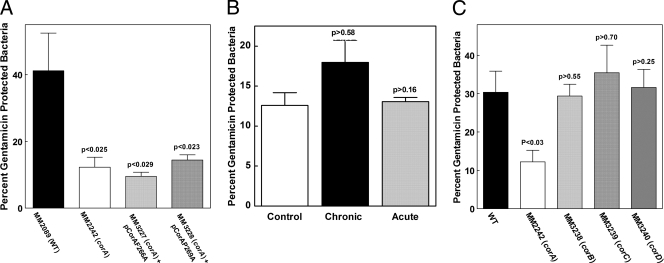FIG. 3.
Inhibition of CorA and the role of Mg2+ efflux in Caco-2 epithelial cell invasion. (A) S. enterica serovar Typhimurium cells were allowed to invade Caco-2 epithelial cells for 1 h, and intracellular bacteria were left to replicate for 6 h in the presence of gentamicin. The effects of mutations of CorA (F266A and P269A) putatively affecting Mg2+ transport on the invasion of Caco-2 epithelial cells were measured. P values indicate t tests comparing the wild type (MM2089) to the F266A and P269A corA mutant strains (MM3227 and MM3228). Data represent the average of two independent experiments. (B) Wild-type S. enterica serovar Typhimurium cells (MM2089) were allowed to invade Caco-2 epithelial cells for 1 h, which were then treated with gentamicin for 1.5 h to kill extracellular bacteria. The effect of chronic (overnight during growth) or acute (immediately prior to invasion) inhibition of CorA with Co(III) hexaammine on Caco-2 cell invasion was measured. The control represents wild-type invasion in the absence of Co(III) hexaammine. In both cases, Co(III) hexaammine was maintained in the medium during invasion. Chronic exposure of the Caco-2 cells to the inhibitor did not affect their viability (data not shown). (C) S. enterica serovar Typhimurium cells were allowed to invade Caco-2 epithelial cells for 1 h, and intracellular bacteria were left to replicate for 6 h in the presence of gentamicin. The effects of mutations of the corB, corC, and corD genes affecting Mg2+ efflux via CorA were determined. P values indicate t tests comparing the wild type (MM2089) to the corB, corC, or corD mutant strain (MM3238, MM3239, or MM3240, respectively). A single experiment representative of three additional experiments is shown.

